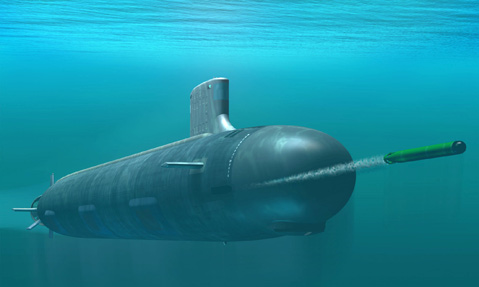Newest Nuclear Sub Could Call Here First
Santa Barbara Navy League Working to Adopt Nuclear-Powered Submarine

Santa Barbara could become first port for the Navy’s newest nuclear-powered submarine, if the Santa Barbara Navy League has its way. As the sub, dubbed PCU California, nears its July 4 debut, the Santa Barbara Navy League (SBNL) has expressed interest in “adopting” it. PCU California Commander Bruce Derenski, alongside Rear Admiral William R. French, were keynote speakers at the SBNL’s annual meeting and reception at the Santa Barbara Maritime Museum on Tuesday, January 25. The two officers gave an update on the Navy’s latest maritime strategies and on progress the Navy has made to become more sustainable and energy efficient.
Although Derenski said that the port call decisions for the newest submarine are still fluid, French was eager to focus on efforts the Navy has made to make the sub environmentally efficient. “The Southwest region is leading everybody when it comes to sustainability, greening, energy conservation, water conservation, and those types of initiatives,” French said during a press conference before the event. “Since 2003, when the Department of Defense started tracking [conservation], the Navy reduced their energy consumption by 21 percent, with the goal by 2013 being 30 percent.” French also said that these transformations emerged from cultural change and having people more aware of the effort to conserve.
Derenski pointed out that the new technological innovations to Virginia-class submarines like the PCU California include a new fiber-optic periscope that is similar to a camera, and a touch-screen torpedo room, as well as paperless command logs. “Digital controls have infiltrated into every aspect of the ship,” Derenski said, “which makes it easier to maintain.” Virginia-class subs typically take around 74 months to build, but the PCU California is down to about 60 months, and Derenski said there are “aggressive efforts” to reduce the completion time for these subs to 54 months, to make them more cost-efficient.
French also said that new maritime strategies address the issues of combating international pirate activity and conducting humanitarian aid relief in nations affected by natural disasters, like Pakistan and Indonesia. “We don’t have to wait for another disaster,” French commented. Over one-third of the Navy’s assets are out there ready to focus on global humanitarian assistance, he said.
As of now, the SBNL has adopted 13 units from all sections of the armed forces, including the crews aboard USS Ronald Reagan and USS Stockdale, and hopes to add PCU California to that list.


